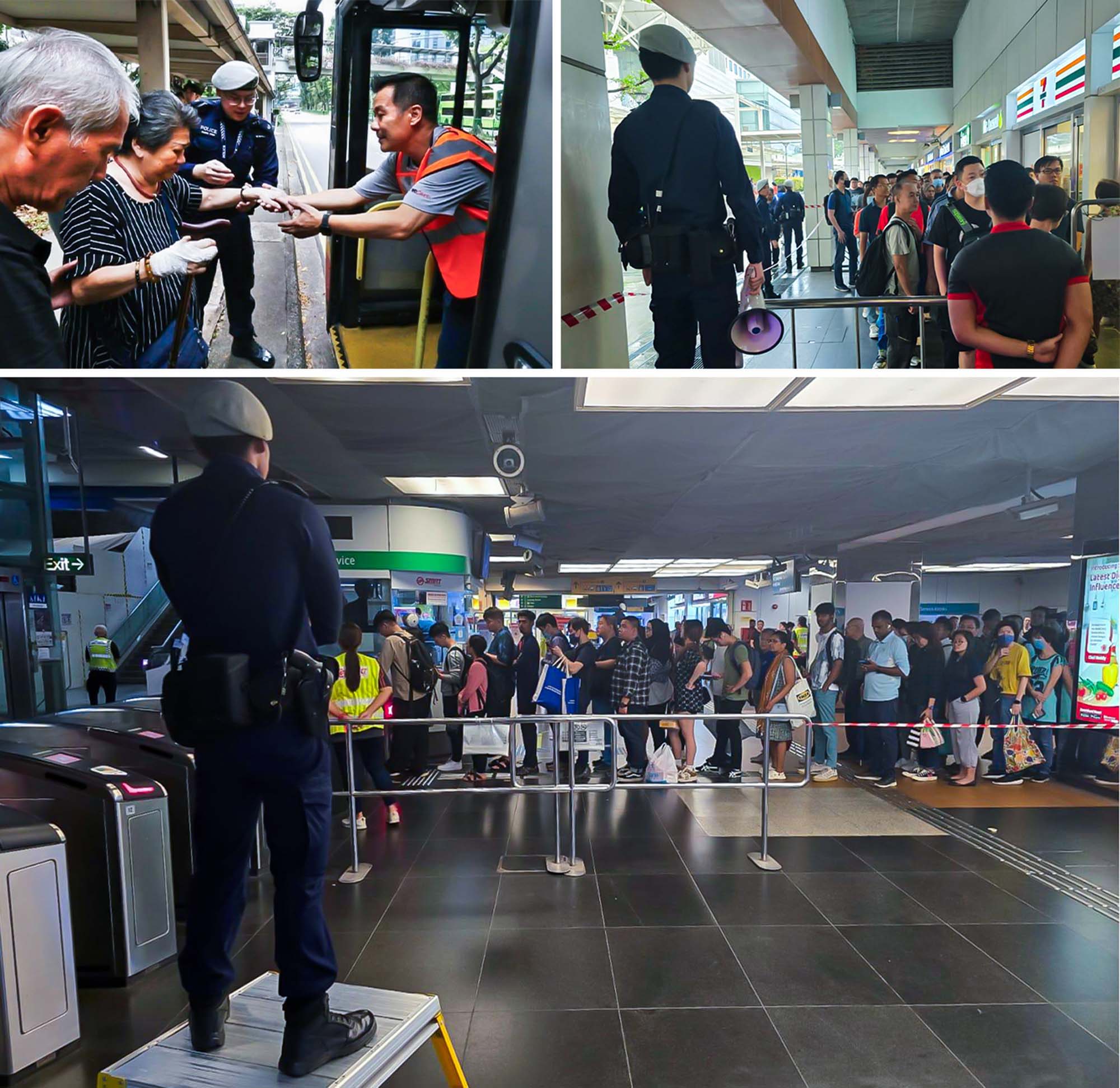Commuters in need, a ticking clock and a commitment to help the public in a critical moment – here’s how our TransCom officers supported SMRT and LTA during the September 2024 East-West MRT Line disruption.
By: Domnic Dass
On 25 September 2024, a major disruption to the East-West MRT Line left thousands of commuters stranded. As the weather turned and lines grew at designated bus bridging areas and entrance towards the shuttle trains at affected MRT stations, Public Transport Security Command (TransCom) officers focused on assisting the SMRT Corporation (SMRT) and Land Transport Authority (LTA) on the ground, supporting commuters and help maintain law and order.

As the first-tier response force for crimes and security incidents in our public transport system, TransCom officers played a crucial role in maintaining public security and safety during the six-day disruption. During the period of train disruption, over 70 TransCom officers, including Officer-Hour Staff (OHS) and Police National Service (PNS) officers, were deployed daily at the affected stations.
Police Life met with Commanding Officer (CO) of Paya Lebar Base, Superintendent of Police (Supt) Andy Foo, and Full-time Police National Service (PNSF) officer Special Constable Corporal (SC/Cpl) Mohamed Aqa'sha Abdillah Mohamed Gazali, to learn about their experiences on the ground.

What are your roles and responsibilities as CO? How did you spring into action during the MRT disruption?
As the CO of Paya Lebar Base, I’m responsible for maintaining public order and preventing disorderly conduct at our designated areas of operation. When the MRT disruption occurred, I quickly deployed my team to Buona Vista MRT Station, which is an interchange with high footfall, to assess the situation, provide support and ensure the safety of the public.

How did TransCom respond to the incident, and what was your top priority?
Our initial goal was to manage the crowds, prevent disorder and ensure public safety. We worked closely with SMRT and LTA officers, transport operators and public agencies to provide alternative transport arrangements and maintain public order.
Over the six days of disruption, we deployed in excess of 70 TransCom officers daily, including our OHS and PNS officers, to help with crowd management and ensure public safety. The officers were primarily deployed to Buona Vista, Jurong East and Boon Lay MRT Stations, while our on-duty officers patrolled other stations.

What was the most significant challenge TransCom faced during the incident, and how did you overcome it?
One of the biggest challenges was the inclement weather, which made the ground slippery and increased the risk of accidents. We had to constantly remind the public to be careful. To maintain the vigilance and morale of our officers despite the long deployment hours and poor weather, we shared the importance of the deployment with the officers during the daily briefing and ensure that they have sufficient water, food and operational equipment to discharge their duties effectively.

Our officers demonstrated exceptional professionalism, empathy, dedication and teamwork, showcasing TransCom’s capabilities in managing complex, unexpected incidents.

As a PNSF TransCom patrol officer, what are your roles and responsibilities?
As a member of the Foot Patrol Group (FPG), I conduct patrols at MRT stations, engaging with commuters and public transport operators. Do you know that about 80% of TransCom officers are PNSF officers?
Can you share your experience on the first day of the MRT disruption?
Train services was suspended in the morning and when I reported for my shift duty at Buona Vista MRT Station in the afternoon, crowds had already began to form. After being briefed by our cluster leaders and supervisors on the situation, we were assigned various duties. I assisted in managing crowds, preventing disorder and helping vulnerable commuters such as the elderly or those with special needs to board the bridging buses.

What were some of the challenges you faced on the ground?
Many commuters were understandably frustrated and we had to remain calm and professional while making many decisions on the spot, such as directing commuters who are taking the bridging services and regular bus services to different lanes. My throat was sore by the end of the day but I’m glad we did our duties well to support commuters.
What were your reflections after normal MRT service was restored after six days?
I was proud of how my team worked together to manage the situation. Our Team Leader played a vital role in coordinating our efforts, and our Deputy Team Leader and regular officers managed the situation well. I was also impressed by the leadership of the National Service Probationary Inspectors and other PNSFs and FPGs who worked together seamlessly!









